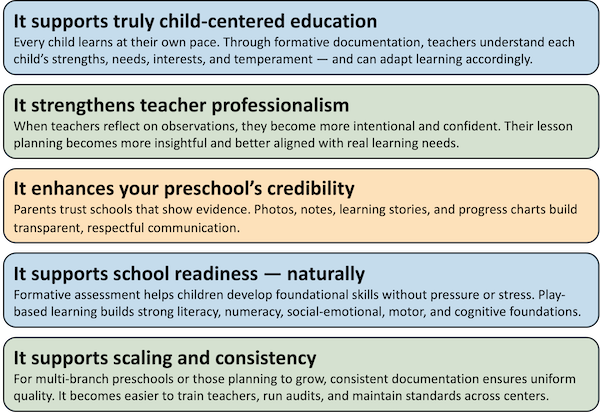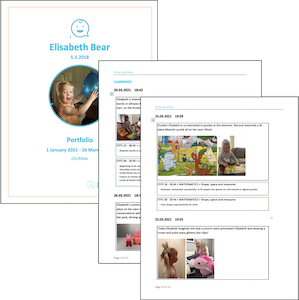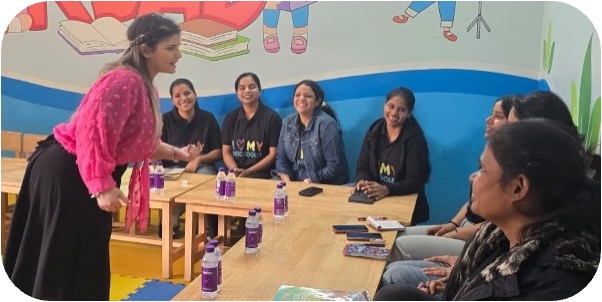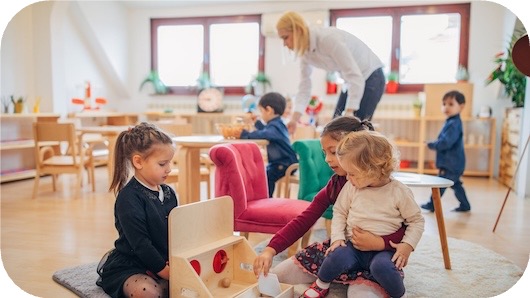Preschool owners are shifting from traditional, teacher-led practices toward more child-centered, play-based, and research-driven approaches inspired by global best practices, especially those of Finland.
Yet one major challenge persists: how to show parents that learning is truly happening every day.
Parents no longer choose preschools only on convenience or buildings. Today’s working, aspirational families want proof:
- What did my child learn today?
- How is my child developing socially, emotionally, and academically?
- Is the preschool truly offering quality, or is it just saying it?
This is where high-quality assessment — especially formative assessment — becomes a defining pillar of any preschool aiming to position itself as premium, holistic, and future-ready.
This blog explains:
1️⃣ Why formative assessment matters in playful classrooms
2️⃣ How it strengthens your school’s brand, parent trust, teacher professionalism, and learning outcomes
3️⃣ Practical ways to embed it in daily preschool life
4️⃣ And finally, how Kindiedays supports your entire observation-to-assessment workflow so your team can deliver quality without extra workload.

1. Why Learning Through Play Needs Thoughtful Assessment
Play is the central driver of learning in early childhood. Through play, children express ideas, test theories, collaborate, solve problems, and regulate emotions.
But here’s the challenge: Learning through play doesn’t look like traditional “studying.” There are no worksheets, no memorization, no drills. So parents may not always understand the deep learning happening beneath the surface.
This makes assessment even more essential. When teachers observe children in action — during free play, group activities, outdoor exploration, music, dance, storytelling, or STEM stations — they make learning visible.
Formative assessment captures the learning journey.
It documents:
- Early attempts
- Small emerging skills
- Social interactions
- Problem-solving moments
- Emotional milestones
- Language growth
- Creativity in action
This day-to-day documentation shows how children think, not just what they know.
Term-end assessments and exams only capture results. Formative assessment captures growth, which matters most in the early years.
2. Why Formative Assessment Is Essential for Premium Preschools
A premium preschool is defined not only by its infrastructure but also by the quality of its learning experiences and its transparency with families.
Here’s how thoughtful assessment elevates your school.

Simply put: Assessment is not an administrative task — it’s a strategic brand advantage.
3. How to Embed Assessment into Daily Preschool Life
Many school owners believe assessment requires extra time or paperwork.
But when done naturally and systematically, it becomes part of the daily flow.
1️⃣ Define clear learning goals
Connect your curriculum to domains like:
- Social-emotional development
- Physical development
- Thinking and problem-solving
- Language and communication
- Creative expression
- Early literacy & numeracy foundations
This helps teachers know what to observe.
2️⃣ Observe naturally during routine activities
A child helping a friend, asking questions, stacking blocks, singing loudly, joining a group — these everyday actions reveal development.
3️⃣ Document moments in simple ways
Short notes, photos, quick videos, audio recordings, learning stories
None of these requires lengthy writing.
4️⃣ Build child portfolios over time
Individual portfolios show each child’s journey from the first day to graduation. Parents love them, teachers rely on them, and school leaders can use them for progress tracking.
5️⃣ Conduct weekly or monthly reflection
Teachers review patterns: Who needs more support? Who is ready for new challenges? How do we adapt next week’s plan?
This is the heart of a responsive, child-centered preschool.
6️⃣ Communicate regularly with parents
Parents feel reassured when they see tangible evidence. Updates should be frequent, meaningful, and connected to learning, not just activities.
4. Assessment Is the Heart of a Premium Preschool — Kindiedays Makes It Possible
Kindiedays was explicitly designed to address the challenges modern preschools face.
Instead of juggling paper files, WhatsApp groups, and scattered documents, Kindiedays brings everything into a single digital workflow — aligned with research-based Finnish pedagogy and adapted to Indian preschool needs.
Here’s how Kindiedays supports your entire assessment lifecycle.
.jpeg)
📲 Smart Digital Tools for Daily Classroom Observations
Kindiedays includes dedicated apps for teachers, parents, and school heads. Teachers can make observations instantly — without disrupting class time.
They can capture:
- Notes
- Photos
- Videos
- Child achievements
- Social interactions
- Learning activities
- Daily routines
Each observation can be linked to learning objectives for more profound insight.
This ensures documentation happens in the moment, not later from memory.

🗓️ Automatic Child Portfolios That Build Themselves
Every documented moment is automatically organized into a child’s digital learning portfolio.
These portfolios become a rich reflection of a child’s growth, including:
- Cognitive skills
- Social-emotional milestones
- Creative exploration
- Early STEM learning
- Physical development
- Communication & language progress
Parents value portfolios among the most meaningful items they receive from a preschool.

📊 Insightful Progress Tracking for Teachers and Center Heads
Kindiedays generates clear, easy-to-understand learning statistics for each child and group.
School leaders gain visibility into:
- Which learning objectives are well-covered
- Which areas need more focus
- How each child or group is progressing
- How consistently do teachers document learning
- Quality across batches or branches
This helps with curriculum planning, audits, teacher training, and long-term school development.

🫶 Strong Parent Engagement Through Transparent Communication
Parents receive timely updates through the app, including:
- Photos and videos
- Daily routines (meals, sleep, hygiene)
- Learning stories
- Highlights from group activities
- Progress summaries
This keeps parents connected to their child’s day and strengthens trust in your preschool.
When parents see real learning every day, satisfaction rises — and so does word-of-mouth enrollment.

⏳ Reduced Teacher Workload — More Teaching, Less Paperwork
Teacher burnout is a real challenge in preschools.
Kindiedays significantly lightens administrative work by:
- Automating reports
- Storing all documentation digitally
- Making observations fast and straightforward
- Eliminating manual portfolios
- Supporting consistent routines
When teachers feel supported, they deliver better experiences for children.
🚀 A Scalable System for Growing Preschool Chains
For owners managing multiple centers — or planning to expand — Kindiedays provides a strong backbone.
You can centrally manage:
- Curriculum settings
- Learning objectives
- Reporting formats
- Teacher accounts
- Parent communication
- Quality benchmarks
This ensures every branch offers the same high standard of education.

Ready to Elevate Your Preschool?
If your vision is to build a school where learning is joyful, transparent, and truly world-class, then formative assessment supported by Kindiedays is your most powerful tool.
You can create:
✅ A school parents trust
✅ A team teachers love working in
✅ A curriculum rooted in play
✅ Evidence of real learning
✅ A brand that stands out in a competitive market
✅ A scalable system for expansion
What next?
👉 Learn more about how Kindiedays can support your preschool with a complete Curriculum Partnership — combining Finnish early education principles, digital tools, lesson plans, and teacher workshops tailored for challenger preschools.

I look forward to meeting you.
Milla van der Burgh
👉 Click here to schedule a consultative call on Zoom or contact me on WhatsApp!
PS Join our official WhatsApp group 👉 click here to join the group!
Kindiedays home page

.png)


.jpeg)








